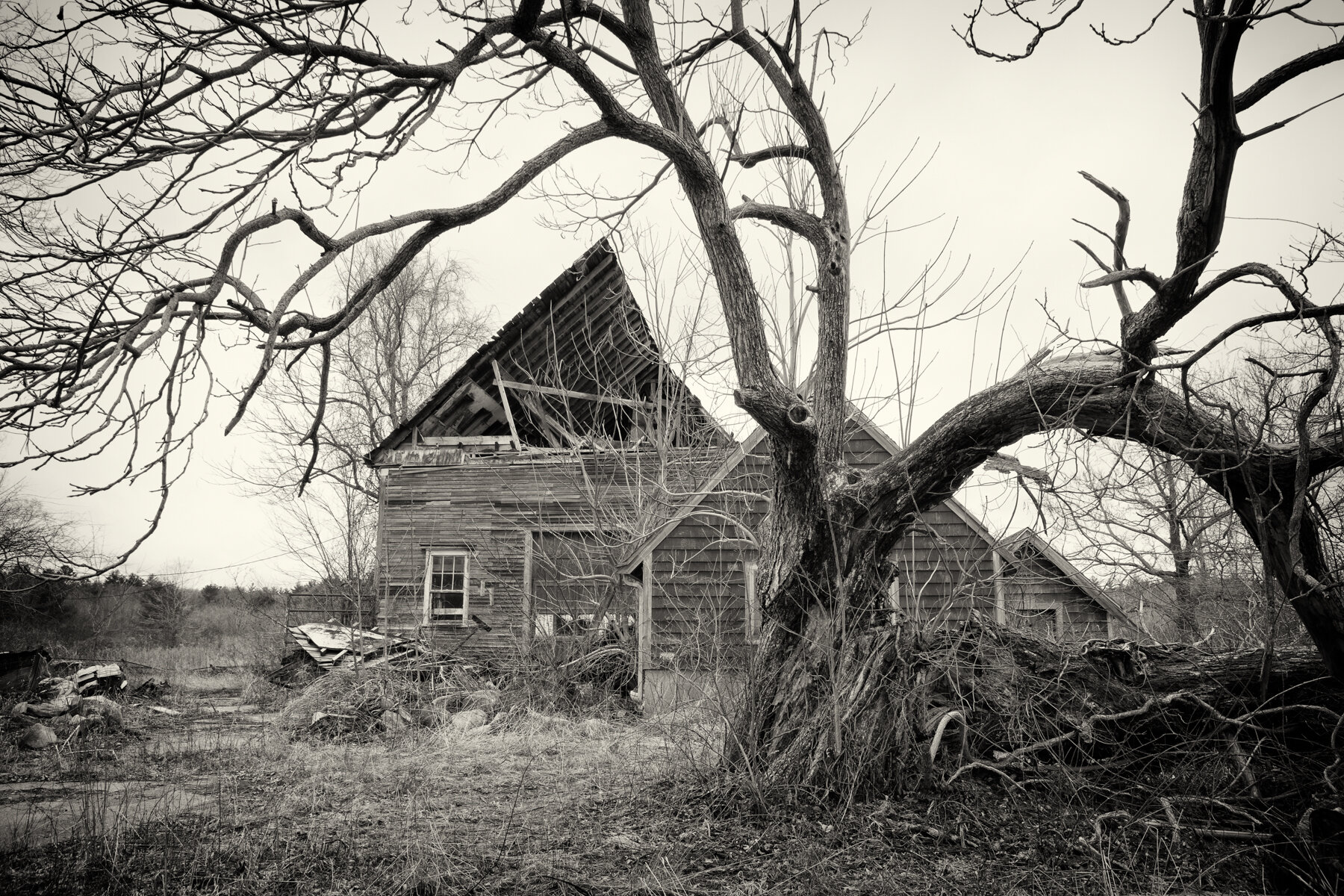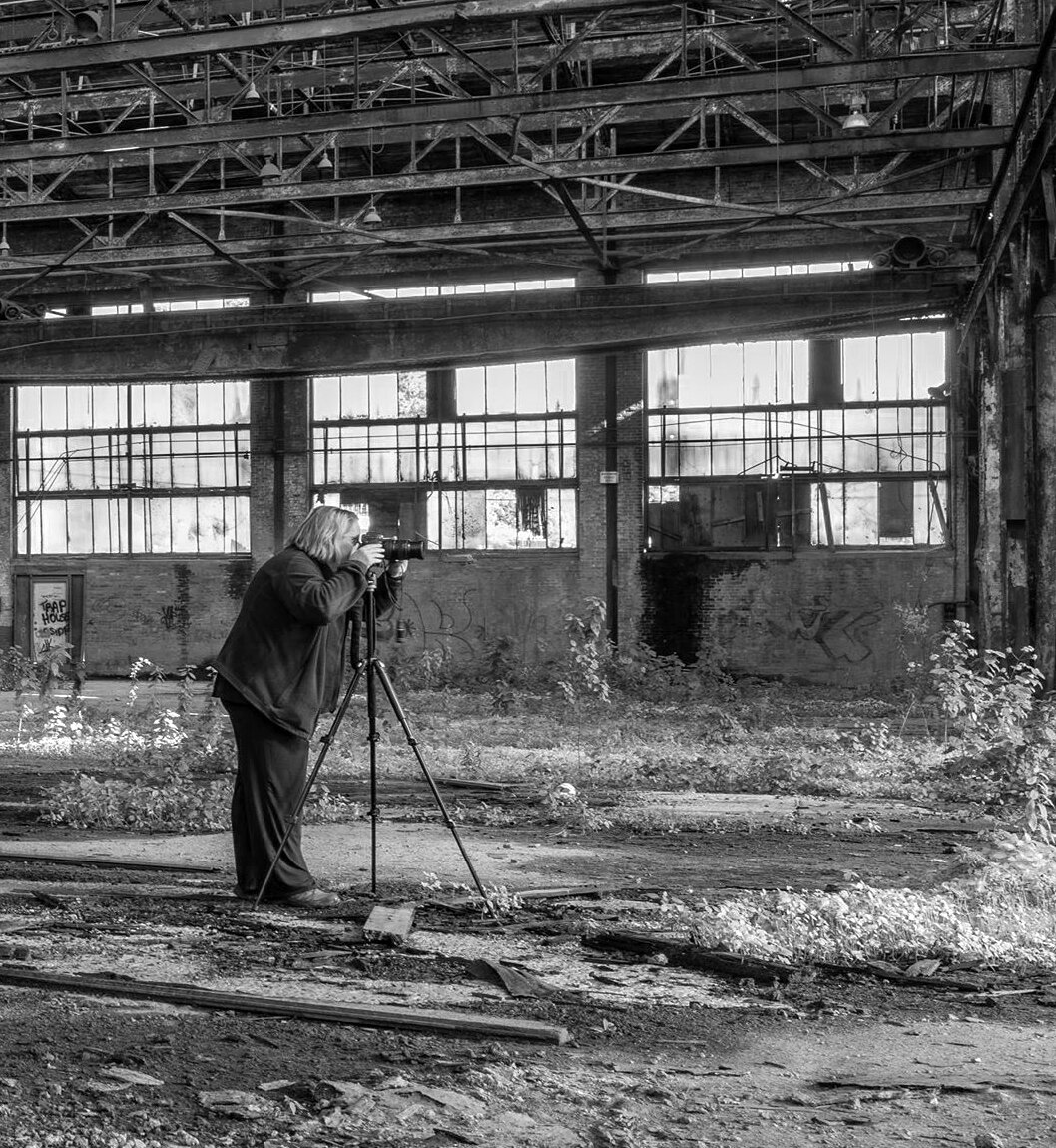Fragments of Time: Rebecca Skinner and David DeMelim
This January in the main gallery we feature core artist Rebecca Skinner and guest artist David DeMelim. Their exhibition, Fragments of Time, runs through Sunday, January 31st. Gallery hours are Saturday and Sunday from 12–4PM and by appointment. There will be a Virtual Artist Talk on Sunday, January 31st at 3PM. Find out more details and RSVP here. In this post, the artists share ideas about their work.
Rebecca Skinner
Abandoned Hospital, NY
Why? I grew up in a semi urban town just south of Boston, MA. As a kid the best places to play would often be abandoned construction sites. You could easily be on another planet, or in an action packed movie! As a teenager, they were dry secluded places to hang and sometimes... misbehave. Once I remember driving down to the fort in Hull in the middle of the night, and seeing who would go furthest into the dark underground. It was definitely not me! On the weekends, I would visit my father’s farm on the South Shore. I would climb the rafters of the old barn and surround myself in the many things he collected. Sometimes my friends and I would pile into one of his antique cars in the woods and go for a fantastical ride. I guess this is where my fascination with the abandoned started.
When I was seventeen I moved to North Carolina and began working in a photo lab as a printer. Looking back on it, becoming a printer was a great way to grow as a photographer. Interestingly, I worked with a girl from Massachusetts who had similar interests as me in old farms and houses. We used to head out to the country searching for interesting spots to photograph. It wasn’t difficult to find anything abandoned in the early 90’s on the outskirts of Raleigh. At one point, we were scolded for trespassing in an abandoned farmhouse. I recall having played dumb, and smiling so sweetly, to get away with that one. At one point, we came across a very large beautiful farmhouse, way out in the middle of nowhere, where the ground was covered in shotgun shells and creepy graffiti. We thought maybe this isn’t the best idea…
Dilapidated Barn, Bridgewater, MA
I found myself back in Massachusetts in the year 2000. My dad would often tell me of places he would like me to photograph. Once, he drove me to an abandoned dairy barn in Lakeville and had no hesitation in walking right in to take a peek around. He would tell me about worn out barns and one that had a roof hanging on by a single beam. I can still hear him saying “You have to photograph it!” His interests in farming, architecture, and antiques shine throughout my work.
Lifted paint chip sculpture in an abandoned hospital, NY
Throughout the years, I continued to capture farms and neglected buildings on occasion, but it wasn’t until around 2010 that I dove back into abandoned locations. I find it so easy to imagine a story to go with each image, and I am often taken aback to find what I photograph–whether it is the way the architecture crumbles and caves, or the way a vine lifts the paint from a wall–are each works of art within themselves. Nature creates its own form of abstract sculpture. Over the years, my hesitation has morphed into comfort. I embrace the silence of these places, and I am always curious of what I might find around the corner. – Rebecca Skinner
Image by Diane Danthony
David DeMelim
Format and Future: The genesis of the current work on display.
I have always been fascinated with panoramic images, from the early Cirkut cameras used early in the 19th century often for large group portraits to the more modern 120 cameras producing 6 shots to a roll - if you were really lucky! The Widelux F7 (a 35mm panoramic camera with the lens in a moving turret) was another fascinating camera platform capable of producing some uniquely distorted images. - A little too distorted for my tastes and well beyond my budget so I started experimenting shooting in pairs with my existing 35mm camera. Working in a horizontal format I would divide the scene to be photographed into a left and right half and use the existing architecture or landscape to incorporate (and hide) the dividing bar between the two adjacent 35mm frames. After processing the film the resulting pairs were printed simultaneously using a 4x5 enlarger. Below are samples of early work. They are adjacent 35mm Pairs.
Early Work: Courtyard View
Early Work: Had a Coke
Early Work: Honda
It didn’t take long to perfect the process, capturing an extended field of view in one (at first look) seamless image. It also didn’t take long to realize that by capturing two distinct moments in time opened up options not possible with conventional panoramic cameras. Moving objects or people could exist in both frames, both moments in time and as long as some of the elements connected across the frame divide the perspective or point of view could be changed… As long as there was a certain amount of continuity the brain would process it as a single scene and fill in the missing pieces.
Film vs Digital:
Having started this journey with a film based camera forced me to develop the ability to pre-visualize how the resulting paired images would work, which lines would align across the divide to create the illusion of a continuous scene. Since the images were simultaneously printed as full frame pairs there was no option to correct misalignment or overlap of the images in the printing process. With film you can’t view the images your shooting while you are in the field, this meant I had to hold the latent image in my mind while setting up for the right hand frame of a pair. I think this discipline was crucial to the success of the newer work created digitally.
Transitioning to a digital camera opened up a number of new possibilities but I held onto the process I had developed shooting film. Decisions related to composition, placement in the resulting sequence and the overall composition of the panorama are made while shooting and executed in post processing. The structure of the left and right frame is held in my head while I seek out the rest of the images. In the post processing assembly process, I use the full frame of each image that gets incorporated into the final Built Panoramic image.
While the resulting work has a visual connection to in-camera multiple exposures, (created by running a roll of film through the camera twice), it really couldn’t be more different in process or intention. The current work included in the “Fragments of Time” exhibition are carefully constructed to present an event or experience in a single image. I record multiple moments, multiple points of view condensing time to capture a series of images to be reassembled later. Unlike in-camera multiple exposure, the resulting compositions and juxtaposition of images is not random but carefully planned. My goal is to capture and present the event the way you might have experienced it in person, a collection of discrete but related images - a collection of discrete fragments of time that more closely relate to how we actually see and experience the world.
My Built Panorama work is ongoing and I expect it to continue indefinitely as I explore the world that passes in front of my lens. Currently I am exploring the potential offered by the latest crop of 360º cameras. These cameras capture a full 360º image in a single instant. While they represent almost the antithesis of my built panoramas, built from multiple moments, multiple points of view they offer a fresh challenge and share a few attributes. Most obvious is the horizontal panoramic format, more interesting however is the similarity of approach, shoot first and finish the composition after in post processing. The 360º camera adds the challenge of how not to be in the photo because there is no “behind the camera” (the camera captures a full 360º sphere) or the opportunity to be in my own photographs...
Me, Myself and I Pandemic 2020








